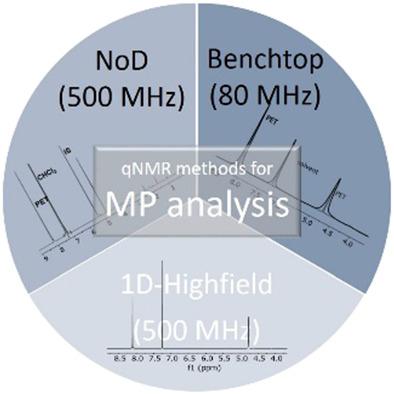当前位置:
X-MOL 学术
›
Magn. Reson. Chem.
›
论文详情
Our official English website, www.x-mol.net, welcomes your
feedback! (Note: you will need to create a separate account there.)
Applicable and cost-efficient microplastic analysis by quantitative 1H-NMR spectroscopy using benchtop NMR and NoD methods
Magnetic Resonance in Chemistry ( IF 1.9 ) Pub Date : 2021-08-20 , DOI: 10.1002/mrc.5210 Nadine Peez 1 , Torsten Rinesch 2 , Jürgen Kolz 2 , Wolfgang Imhof 1
Magnetic Resonance in Chemistry ( IF 1.9 ) Pub Date : 2021-08-20 , DOI: 10.1002/mrc.5210 Nadine Peez 1 , Torsten Rinesch 2 , Jürgen Kolz 2 , Wolfgang Imhof 1
Affiliation

|
In continuation of our work on the proof-of-concept that quantitative NMR spectroscopy may be a valuable tool in microplastic (MP) analysis and quantification, we present here investigations using low-field NMR spectrometers and nondeuterated solvents for the analysis of solutions of MP particles in suitable solvents. The use of low-field NMR spectrometers (benchtop NMR) that are considerably more cost-effective in terms of purchase and operating costs compared with high-field NMR spectrometers and the use of nondeuterated solvents (NoD method) leads to an applicable and cost-efficient method for mass-based MP analysis. For benchtop 80-MHz NMR, limits of detection for polyvinylchloride (PVC), polyethylene terephthalate (PET), and polystyrene (PS) are in the same range as if a high-field 500-MHz NMR spectrometer was used for quantification (500 MHz: PET 1 μg/ml, PVC 42 μg/ml, and PS 9 μg/ml; 80 MHz: PET 4 μg/ml, PVC 19 μg/ml, and PS 21 μg/ml) for polymers being dissolved in deuterated solvents. The same is true for the corresponding limits of quantification. Moreover, it is shown for the first time that quantitative determination of the mass concentration of PET, PVC, and PS is also possible using NoD methods by evaluating the integrals of polymer-specific signals relative to an internal or external standard. Detection limits for NoD methods are in a similar range as if deuterated solvents were used (PET 2 μg/ml, PVC 39 μg/ml, and PS 8 μg/ml) using a high-field 500-MHz spectrometer or the 80-MHz spectrometer (PET 5 μg/ml).
中文翻译:

使用台式 NMR 和 NoD 方法通过定量 1H-NMR 光谱进行适用且经济高效的微塑料分析
为了继续我们的概念验证工作,即定量 NMR 光谱可能是微塑料 (MP) 分析和量化的宝贵工具,我们在此介绍了使用低场 NMR 光谱仪和非氘化溶剂分析 MP 溶液的研究颗粒在合适的溶剂中。与高场核磁共振波谱仪相比,使用低场核磁共振波谱仪(台式核磁共振)在购买和操作成本方面更具成本效益,并使用非氘化溶剂(NoD 方法)导致适用和成本-基于质量的 MP 分析的有效方法。对于台式 80-MHz NMR,聚氯乙烯 (PVC)、聚对苯二甲酸乙二醇酯 (PET) 和聚苯乙烯 (PS) 的检测限与使用高场 500-MHz NMR 光谱仪进行定量(500 MHz :PET 1 μg/ml、PVC 42 μg/ml 和 PS 9 μg/ml;80 MHz:PET 4 μg/ml、PVC 19 μg/ml 和 PS 21 μg/ml)用于溶解在氘代溶剂中的聚合物。相应的定量限也是如此。此外,首次表明,通过评估聚合物特定信号相对于内部或外部标准的积分,使用 NoD 方法也可以定量测定 PET、PVC 和 PS 的质量浓度。NoD 方法的检测限与使用高场 500-MHz 光谱仪或 80-MHz 的氘化溶剂(PET 2 μg/ml、PVC 39 μg/ml 和 PS 8 μg/ml)类似光谱仪(PET 5 μg/ml)。相应的定量限也是如此。此外,首次表明,通过评估聚合物特定信号相对于内部或外部标准的积分,使用 NoD 方法也可以定量测定 PET、PVC 和 PS 的质量浓度。NoD 方法的检测限与使用高场 500-MHz 光谱仪或 80-MHz 的氘化溶剂(PET 2 μg/ml、PVC 39 μg/ml 和 PS 8 μg/ml)类似光谱仪(PET 5 μg/ml)。相应的定量限也是如此。此外,首次表明,通过评估聚合物特定信号相对于内部或外部标准的积分,使用 NoD 方法也可以定量测定 PET、PVC 和 PS 的质量浓度。NoD 方法的检测限与使用高场 500-MHz 光谱仪或 80-MHz 的氘化溶剂(PET 2 μg/ml、PVC 39 μg/ml 和 PS 8 μg/ml)类似光谱仪(PET 5 μg/ml)。
更新日期:2021-08-20
中文翻译:

使用台式 NMR 和 NoD 方法通过定量 1H-NMR 光谱进行适用且经济高效的微塑料分析
为了继续我们的概念验证工作,即定量 NMR 光谱可能是微塑料 (MP) 分析和量化的宝贵工具,我们在此介绍了使用低场 NMR 光谱仪和非氘化溶剂分析 MP 溶液的研究颗粒在合适的溶剂中。与高场核磁共振波谱仪相比,使用低场核磁共振波谱仪(台式核磁共振)在购买和操作成本方面更具成本效益,并使用非氘化溶剂(NoD 方法)导致适用和成本-基于质量的 MP 分析的有效方法。对于台式 80-MHz NMR,聚氯乙烯 (PVC)、聚对苯二甲酸乙二醇酯 (PET) 和聚苯乙烯 (PS) 的检测限与使用高场 500-MHz NMR 光谱仪进行定量(500 MHz :PET 1 μg/ml、PVC 42 μg/ml 和 PS 9 μg/ml;80 MHz:PET 4 μg/ml、PVC 19 μg/ml 和 PS 21 μg/ml)用于溶解在氘代溶剂中的聚合物。相应的定量限也是如此。此外,首次表明,通过评估聚合物特定信号相对于内部或外部标准的积分,使用 NoD 方法也可以定量测定 PET、PVC 和 PS 的质量浓度。NoD 方法的检测限与使用高场 500-MHz 光谱仪或 80-MHz 的氘化溶剂(PET 2 μg/ml、PVC 39 μg/ml 和 PS 8 μg/ml)类似光谱仪(PET 5 μg/ml)。相应的定量限也是如此。此外,首次表明,通过评估聚合物特定信号相对于内部或外部标准的积分,使用 NoD 方法也可以定量测定 PET、PVC 和 PS 的质量浓度。NoD 方法的检测限与使用高场 500-MHz 光谱仪或 80-MHz 的氘化溶剂(PET 2 μg/ml、PVC 39 μg/ml 和 PS 8 μg/ml)类似光谱仪(PET 5 μg/ml)。相应的定量限也是如此。此外,首次表明,通过评估聚合物特定信号相对于内部或外部标准的积分,使用 NoD 方法也可以定量测定 PET、PVC 和 PS 的质量浓度。NoD 方法的检测限与使用高场 500-MHz 光谱仪或 80-MHz 的氘化溶剂(PET 2 μg/ml、PVC 39 μg/ml 和 PS 8 μg/ml)类似光谱仪(PET 5 μg/ml)。









































 京公网安备 11010802027423号
京公网安备 11010802027423号